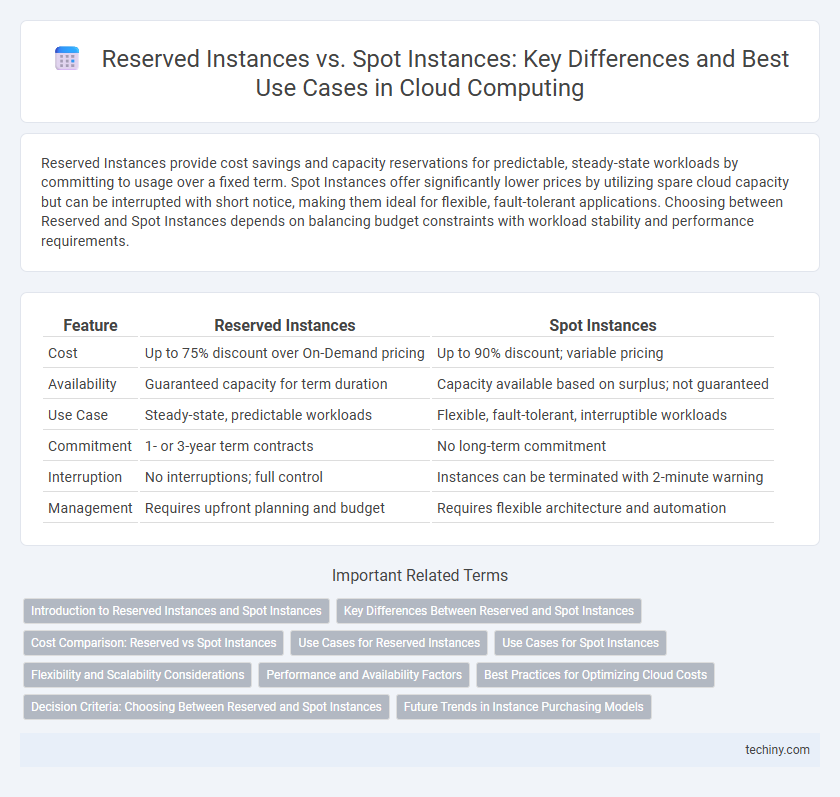Reserved Instances provide cost savings and capacity reservations for predictable, steady-state workloads by committing to usage over a fixed term. Spot Instances offer significantly lower prices by utilizing spare cloud capacity but can be interrupted with short notice, making them ideal for flexible, fault-tolerant applications. Choosing between Reserved and Spot Instances depends on balancing budget constraints with workload stability and performance requirements.
Table of Comparison
| Feature | Reserved Instances | Spot Instances |
|---|---|---|
| Cost | Up to 75% discount over On-Demand pricing | Up to 90% discount; variable pricing |
| Availability | Guaranteed capacity for term duration | Capacity available based on surplus; not guaranteed |
| Use Case | Steady-state, predictable workloads | Flexible, fault-tolerant, interruptible workloads |
| Commitment | 1- or 3-year term contracts | No long-term commitment |
| Interruption | No interruptions; full control | Instances can be terminated with 2-minute warning |
| Management | Requires upfront planning and budget | Requires flexible architecture and automation |
Introduction to Reserved Instances and Spot Instances
Reserved Instances provide a cost-effective way to commit to cloud resources for a fixed term, typically one or three years, offering significant discounts compared to on-demand pricing. Spot Instances leverage unused cloud capacity at steeply reduced rates but come with the risk of sudden termination when demand spikes. Both options optimize cloud spending by balancing cost savings and workload flexibility based on business needs.
Key Differences Between Reserved and Spot Instances
Reserved Instances offer a predictable and consistent pricing model by committing to a one- or three-year term, making them ideal for steady-state workloads requiring long-term capacity. Spot Instances provide access to unused cloud capacity at significantly reduced rates but can be interrupted by the cloud provider with little notice, suited for flexible, fault-tolerant applications. The key differences lie in cost stability, availability guarantees, and workload suitability, with Reserved Instances ensuring reserved capacity and Spot Instances offering cost savings with variable availability.
Cost Comparison: Reserved vs Spot Instances
Reserved Instances offer a predictable and lower hourly rate by committing to usage over one or three years, providing significant cost savings compared to on-demand pricing. Spot Instances enable access to unused cloud capacity at discounts up to 90%, making them highly cost-effective for flexible, interruptible workloads. Choosing between Reserved and Spot Instances depends on workload stability, with Reserved Instances suited for steady-state applications and Spot Instances ideal for cost-sensitive, fault-tolerant tasks.
Use Cases for Reserved Instances
Reserved Instances are ideal for businesses with predictable, steady-state workloads, such as enterprise applications, databases, and web servers that require consistent compute capacity over long periods. They offer significant cost savings compared to on-demand pricing by committing to a one- or three-year term, making them suitable for baseline infrastructure that demands high availability. Use cases include mission-critical applications, legacy systems, and compliance workloads where uptime and performance stability are paramount.
Use Cases for Spot Instances
Spot Instances offer cost-effective solutions for fault-tolerant, flexible workloads such as big data analysis, batch processing, and containerized applications. These instances are ideal for high-performance computing tasks that can tolerate interruptions due to their dynamic pricing model. Cloud architects leverage Spot Instances to optimize cloud spend while ensuring scalability for non-critical or easily recoverable services.
Flexibility and Scalability Considerations
Reserved Instances offer predictable costs and consistent capacity by committing to long-term usage, making them ideal for stable workloads with steady demand. Spot Instances provide significant cost savings through unused cloud capacity but come with the risk of sudden termination, requiring applications to be highly flexible and fault-tolerant. Scalability with Spot Instances is dynamic and cost-efficient for variable workloads, whereas Reserved Instances prioritize reliability and budget control for fixed, scalable needs.
Performance and Availability Factors
Reserved Instances offer consistent performance and high availability by reserving capacity in advance, ensuring dedicated resources for your workloads. Spot Instances provide cost savings but have variable availability and performance due to potential interruptions when AWS reclaims capacity. Choosing between these depends on the criticality of workload stability and tolerance for downtime versus budget constraints.
Best Practices for Optimizing Cloud Costs
Reserved Instances offer significant cost savings by committing to long-term usage with predictable workloads, ensuring stable capacity and lower hourly rates. Spot Instances provide access to unused cloud capacity at deep discounts, ideal for flexible, fault-tolerant applications that can handle interruptions. Combining these options strategically--using Reserved Instances for baseline demand and Spot Instances for variable, non-critical workloads--optimizes cloud costs while maintaining performance and availability.
Decision Criteria: Choosing Between Reserved and Spot Instances
Choosing between reserved and spot instances in cloud computing depends on workload predictability, budget constraints, and required availability. Reserved instances suit steady, long-term applications with consistent usage, offering cost savings through committed capacity. Spot instances are ideal for flexible, fault-tolerant tasks that can handle interruptions, providing significant cost reductions but less reliability.
Future Trends in Instance Purchasing Models
Reserved Instances will evolve with greater flexibility, offering more granular commitment periods and enhanced cost-saving options for predictable workloads. Spot Instances are expected to integrate advanced machine learning algorithms to optimize bidding strategies and improve instance availability during fluctuating demand. Hybrid purchasing models combining reserved and spot benefits will gain traction, enabling enterprises to balance cost efficiency and workload reliability dynamically.
Reserved Instances vs Spot Instances Infographic

 techiny.com
techiny.com